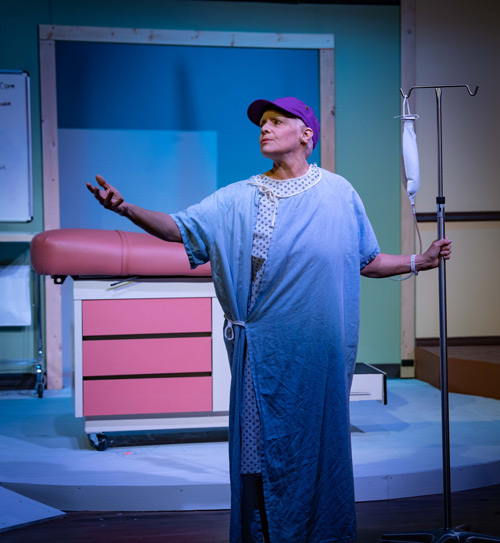By LARRY ADAMS
A Seat on the Aisle
“What we’ve come to think of as me is, in fact, just a specimen jar.”
“It’s not wit. It’s Truth.”
You’d be forgiven if a show about terminal cancer doesn’t top your imagined list of fun activities for an evening out. The disease, as well as the barrage of medical procedures and treatments which accompany it, are ugly, heartrending, and often dehumanizing. Most of us have known someone dealing with it – family, friends, perhaps even ourselves – and it is not something lightly revisited.
But art, at its best, is not about the mundane or even dreadful mechanics of life, but rather their meaning. Art attempts to elevate the human condition without minimizing or trivializing its tragedy. And Wit, Margaret Edon’s 1999 Pulitzer Prize winner for drama and the latest offering at the Basile Westfield Playhouse, largely succeeds in this endeavor with its treatment of one of the worst of life’s tragedies.
Narrated directly to the audience by its cancer victim protagonist, Wit tells the story of the last, painful weeks of the life of Dr. Vivian Bearing, a Ph.D in literature who finds herself in a losing battle with her disease. Initially proud and confident of her ability to intellectualize complex matters and thus handle her predicament (“It appears to be a matter of life and death; I know all about life and death”), Bearing finds her trust in intellectualism failing as her disease relentlessly progresses to its inevitable result.
“It’s like I’m a student,” she laments, “and this is the final exam; and I don’t know what to put down because I don’t understand the question.”
Her doctors’ scientific yet cold detachment merely seems to compound her suffering; in the end, the renowned professor finds that only the simple touch of human compassion offers any real or lasting comfort in life.
Playwright Edson, a former oncology ward clerk with an M. A. in English literature, takes on a rather daunting and I suspect personal challenge with this highly acclaimed work: how to make accessible that which we all would rather avoid. To that end, she wisely holds the running time to just over 90 minutes (though an even more liberal use of the cutting room floor would have helped the overly drawn-out final scene) and lavishes a healthy dose of wry humor over the entire proceeding. The latter not only helps to inform the personality of her protagonist but also attempts to balance out the overwhelmingly ponderous weight of the subject material. It doesn’t always work, but not for lack of effort, and there are indeed some genuinely laugh-out-loud moments.

Beverly Roche as Dr. Vivian Bearing, Ph.D. (Photo by Rob Slaven / IndyGhostLight.com)
Weaknesses in the script are apparent, however. While Ms. Edson’s protagonist is exceedingly well fleshed out, I find the rest of her characters disappointingly two dimensional. Only the young nurse, Susie Monahan, criticized at one point for being less than intellectual, is portrayed as anything approaching human. In particular, the two doctors, Kelekian and Posner, are simple stereotypes of heartless clinicians and medical researchers, serving as little more than punching bags for what I can only guess is the playwright’s disdain of the medical profession.
“Everything is a threat to me,” Bearing at one point proclaims to the audience, “particularly health care professionals.”
This is nowhere more apparent than at the play’s end, in which a rather poignant moment between two characters nicely bookends the show and beautifully contrasts the value of simplicity and humanity with the play’s overarching theme of complexity and detached intellectualism – that is, until the playwright insists on a frankly preposterously played out and over-the-top-final sequence which adds nothing more than a last jab at the medical profession.
I’ve long said that most of us doctors are jerks, and Lord knows modern medicine has made itself an easy target for such a characterization, but a little character development and nuance would’ve served the play much better.
Despite these flaws, Main Street Productions serves up a compelling and well-crafted piece in Wit. Beverly Roche is stunning as Vivian Bearing in what amounts to a 90-minute monologue occasionally interrupted by bits of conversation. She is alternately smug, fearful, confident and terrified through the course of the evening, but always, eminently believable.
As the doctors, Mark Kamish and Connor Phelan truly make the most out of what are, as mentioned, fairly thinly written characters. Becca Bartley embodies competence and compassion in her portrayal of Nurse Monahan, and I was particularly touched by Susan Hill in her final scene as Bearing’s graduate school mentor, Dr. E. M. Ashford.
Eric Bowman, Leah Hoover, Mary Anne Matthews and Teresa Otis Skelton round out the cast in various parts, inhabiting each fully while admirably resisting the urge to overact that is often tempting in smaller roles.
Direction of the show is adeptly handled by Co-Directors Eric Bryant and Becky Schlomann. Scenes flow smoothly from one area of the stage to the next, and from narration to present-day action to the occasional flashback. Pacing is kept tight, never allowing the audience member’s attention to drift (though if I had ever taken THAT long to do a pelvic exam in my practice, I have a feeling the police would have been involved).
The set design by Ian Marshall-Fisher, nicely manifested by Building for the Boards (a new and innovative option for Indianapolis community theaters which I think is deserving of some publicity here), takes full advantage of the Basile Theater’s ample stage space, employing contrasts between a warmer office setting, starkly utilitarian medical examination areas, and an appropriately drab and impersonal hospital room (which frankly had me making a mental note to put home hospice on speed dial for when my time comes). Lighting design by Eric Matters complements and adds to the ambience without distracting, save for a couple of impressive and intentional visual effects.
My one technical complaint is a common one, and, I’m afraid, a particularly common one at the Basile Westfield Playhouse: vocalization. As nice as the Playhouse is in almost every other consideration, it is a bit of an acoustical nightmare from an actor’s – and an audience’s – perspective. Volume and enunciation, always important no matter the venue, are all the more essential in this space for some reason. Scenes of intentionally overlapping dialogue were completely lost on me this night, as were most lines delivered upstage, to the wings or even up toward the fly loft. If the actors are open to any one suggestion, a bit of cheating out with your dialogue would work wonders.
“Death be not proud,” wrote the 17th century English poet John Donne in a sonnet referenced throughout Wit, and indeed it is not. Not proud, rarely glorious, often degrading.
But it can hold meaning. And perspective. And release, and humanity, and redemption.
“That which is so universal as death must be a blessing,” wrote Cornell Woolrich. “And none may escape its benediction.”
Wit, at its best, reminds us that each of us must face death, but each of us also has a choice in how to do so. And once done, as Donne wrote centuries ago, “death shall be no more; death, thou shalt die.”
Read more great play reviews from A Seat on the Aisle at asota.wordpress.com.


Be the first to comment on "In long play review, doctor says play could use some cuts"